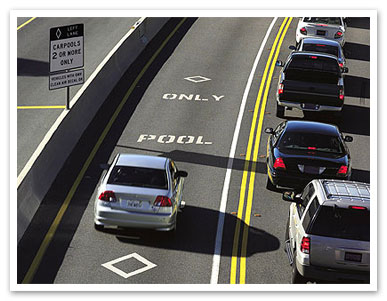How to Use a Carpool Lane
Carpool lanes can be a lifesaver for commuters, but not everyone understands how they work.
What is a carpool lane?
There are many names for this type of lane, including:
- Carpool lanes
- High-occupancy vehicle lanes (i.e., HOV lanes)
- Diamond lanes
- 2+ lanes
- Transit lanes
These names refer to a type of traffic lane that's reserved specifically for vehicles with multiple passengers. Carpool lanes are located next to the normal lanes of traffic and are marked with a sign indicating the minimum number of passengers required for a vehicle to use the lane. There are over 300 carpool lanes in the US.
 Carpool Lane Markings
Carpool Lane Markings
Carpool lanes are meant to encourage ridesharing. There is usually lighter traffic in the carpool lane, which helps commuters get to their destination without waiting in traffic. The risk for collisions is also decreased when there are fewer vehicles on the road. Carpool lanes aren't available on every roadway. Check with your state's Department of Transportation for a list of available carpool lanes.
Are carpool lanes better for the environment?
Air pollution from traffic is a big problem. There are two sources of auto emissions: evaporative emissions and exhaust emissions. Evaporative emissions occur when gasoline in your fuel tank and in your fuel lines evaporates and releases volatile organic compounds into the air. Exhaust emissions are the waste products of a car’s engine that are produced during the combustion process and passed out of the exhaust pipe. Most of a car’s emissions are made up of carbon dioxide (CO2), nitrogen gas (N2), and water vapor (H2O).
Large quantities of these pollutants damage our air quality and have an adverse effect on our planet. Studies vary when it comes to exactly how much carpool lanes help the environment. Even so, when commuters carpool, catch the bus, or ride a bike, at least there are fewer vehicles on the road contributing to air pollution that day.
Who counts as a passenger in an HOV lane?
It's a federal law that children of any age (including infants) count as passengers in a carpool lane. A pregnant person counts as only one passenger. The other requirements vary depending on the state and the roadway. Some carpool lanes allow a minimum of two passengers per vehicle, while others require at least three passengers.
In most cases, motorcycles, passenger vehicles with the at least the minimum number of passengers, transit vehicles (e.g., buses), and emergency vehicles can use the carpool lane. In some areas, clean-air or "green" vehicles may be given a permit to use carpool lanes, even if they are driving alone.
Be sure to verify the requirements before using a carpool lane.
What happens if someone misuses the carpool lane?
Law enforcement can stop vehicles who are misusing the carpool lane. Sometimes, drivers will face a fine, or they may just be redirected to join the normal flow of traffic.
How to Use a Carpool Lane
You can usually enter a carpool lane as you would any other lane: signaling that you're changing lanes, checking your mirrors and your blind spots, then moving into the lane when it's safe to do so. The carpool lane will be clearly-marked, and you must follow traffic laws as you typically would when entering a carpool lane. Do not speed, cut people off, or illegally drive over yellow lines to reach the carpool lane.
You cannot use a carpool lane just to pass other vehicles.
Take an Online Course to Learn More
We offer courses in a variety of topics including Defensive Driving and Driver Education. In addition to teaching you how to be a safe driver, our courses can help you dismiss a ticket, get your driver license, or even get an insurance discount. We also have courses specifically tailored to mature drivers (i.e., drivers age 55 and older) for insurance discounts.